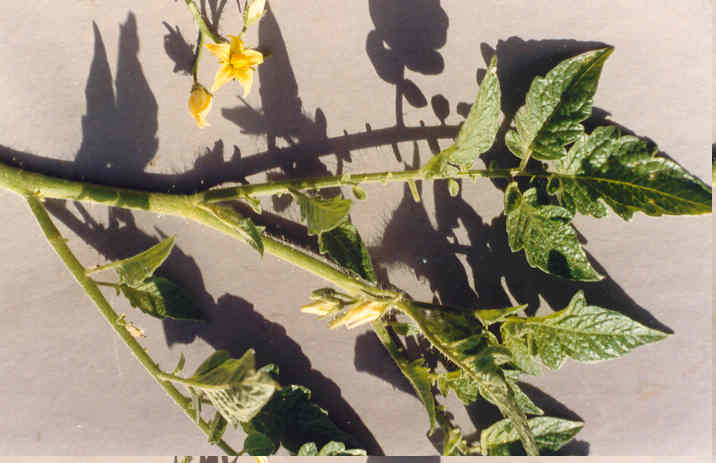Lycopersicon hybrid
|
|
Lycopersicon hybrid
Solanaceae (Nightshade Family)South AmericaRoma VF Tomato |
August Photo
Plant Characteristics:
Spreading, slightly pubescent annual or short-lived perennial, with a few longer
glandular hairs, +/- 4 dm. tall and 1.5 m. across, herbage with a strong scent;
lvs. odd-pinnate, ovate in outline, over 2 dm. long and nearly as wide; with 7
main lfts., and several smaller interposed on the stem, the longest 5-9 cm. long
and 3-5 cm. wide, acuminate, margins irregular and tending to roll inwards; fls.
3-7, nodding, 1.5 cm. or more across, on jointed pedicels; fruit red, oblong in
shape with a broad-cuspidate tip on some, 4-4.5 cm. in diam., 5.5-6.5 cm. long.
(description mine using characteristics listed in Bailey).
Habitat: Escape from cultivation.
Summer-fall.
Name:
Greek, lycoper-sicon, wolf peach, probably in reference to
supposed poisonous qualities. (Bailey
869).
General:
Rare in the study area, found only once and this at the upper end of Big
Canyon. I suspect that this plant
may have been planted, however, there is no evidence that it has been watered.
If planted, it was done well, the plant growing at the foot of a pile of
loose dirt which would soak up moisture in wet weather and also concentrate
excess water at the bottom of the pile. (my
comments). The tomato
plant is called a "vine", it is really
a sprawling plant incapable of climbing, but by common usage it's a vine.
(Sunset Editors, New Western Garden Book 1984, p 486).
About a half dozen S. American soft herbs, per. and perhaps annual, two
of them grown for the edible fruit; sometimes united with Solanum but
differing in being always unarmed, lvs. always pinnate or pinnatifid, and
particularly in the anthers which are projected into sharp or narrow sterile
tips and which dehisce from top to bottom.
(Bailey 869).
A study has found the first direct evidence that the nutrient that makes
tomatoes red may protect men against prostate cancer by shrinking tumors and
slowing their spread. The nutrient,
lycopene, has emerged as one of the trendiest of all supplements in recent
years. Large population surveys have suggested that those who eat
plenty of tomatoes, the primary source of lycopene, are less likely to get
prostate cancer and some other malignancies.
To see if tomatoes are truly the reason why, researchers from the
Karmanos Cancer Institute in Detroit gave lycopene capsules to men who were
about to undergo surgery to remove their cancerous prostate glands. The study involved 33 men who were randomly assigned to take
lycopene for 30 days before their prostate operations. Before surgery, the
volunteers showed no obvious signs that their cancer had spread. After surgery, the doctors found that cancer tissue was less
likely to extend clear to the edges of the lycopene users' prostate glands.
And precancerous cells in their prostates were less abnormal-looking.
"The results are significant," said Dr. Frank Rauscher of the
Wistar Institute in Philadelphia. "It's
remarkable that lycopene may have both therapeutic and preventative value." (Associated
Press Release, Los Angeles Times 13 April 1999. Morning Edition A 11).
Text Ref:
Bailey 869; Munz, Flora So. Calif. 834; Sunset Editors 486.
Photo Ref:
May-July 92 # 22,23.
Genus identity: by R. De Ruff.
First Found: June 1992.
Computer
Ref: Plant Data 439.
Have plant specimen.
Last edit 11/8/04.
 |
June Photo August Photo